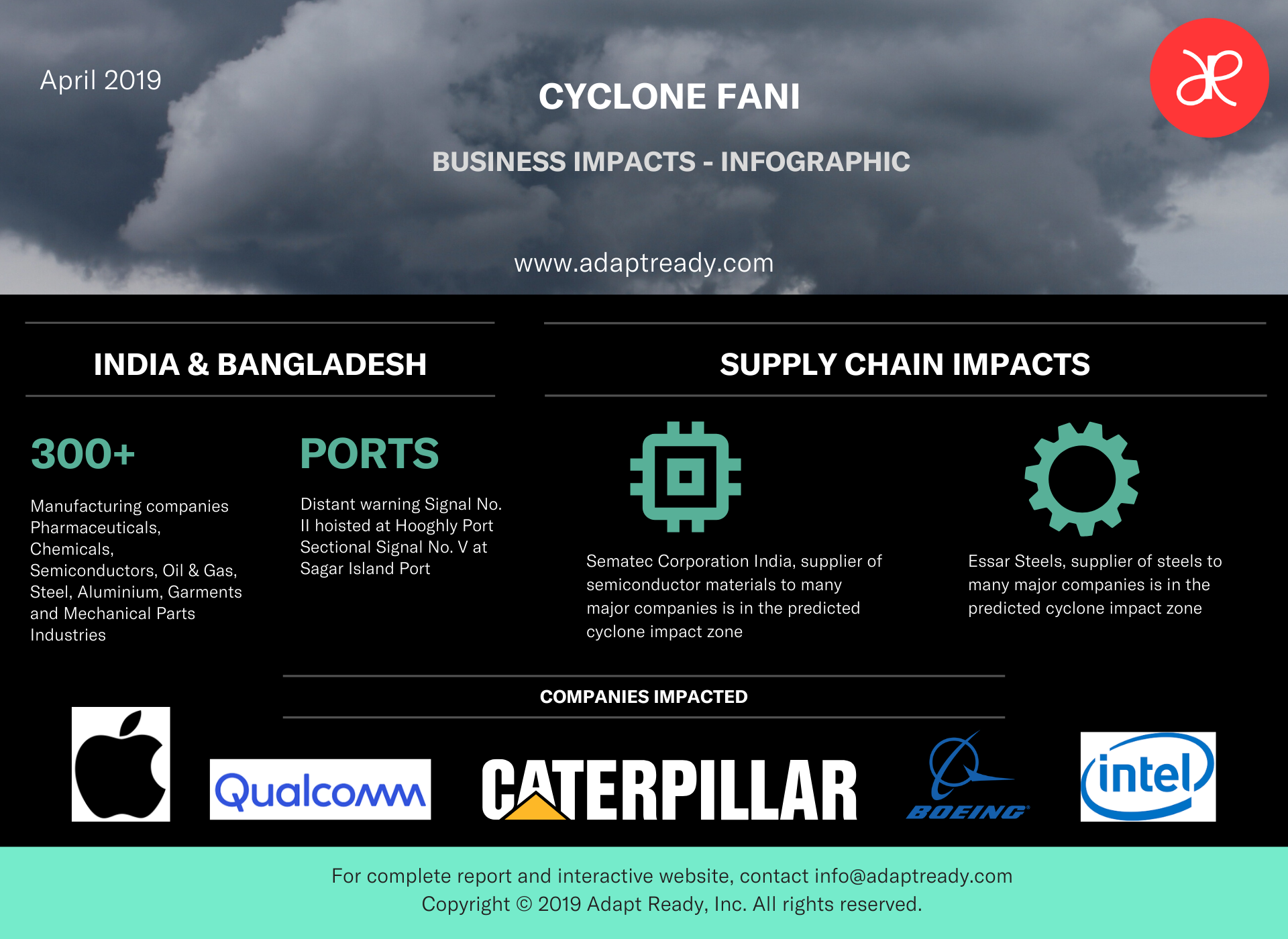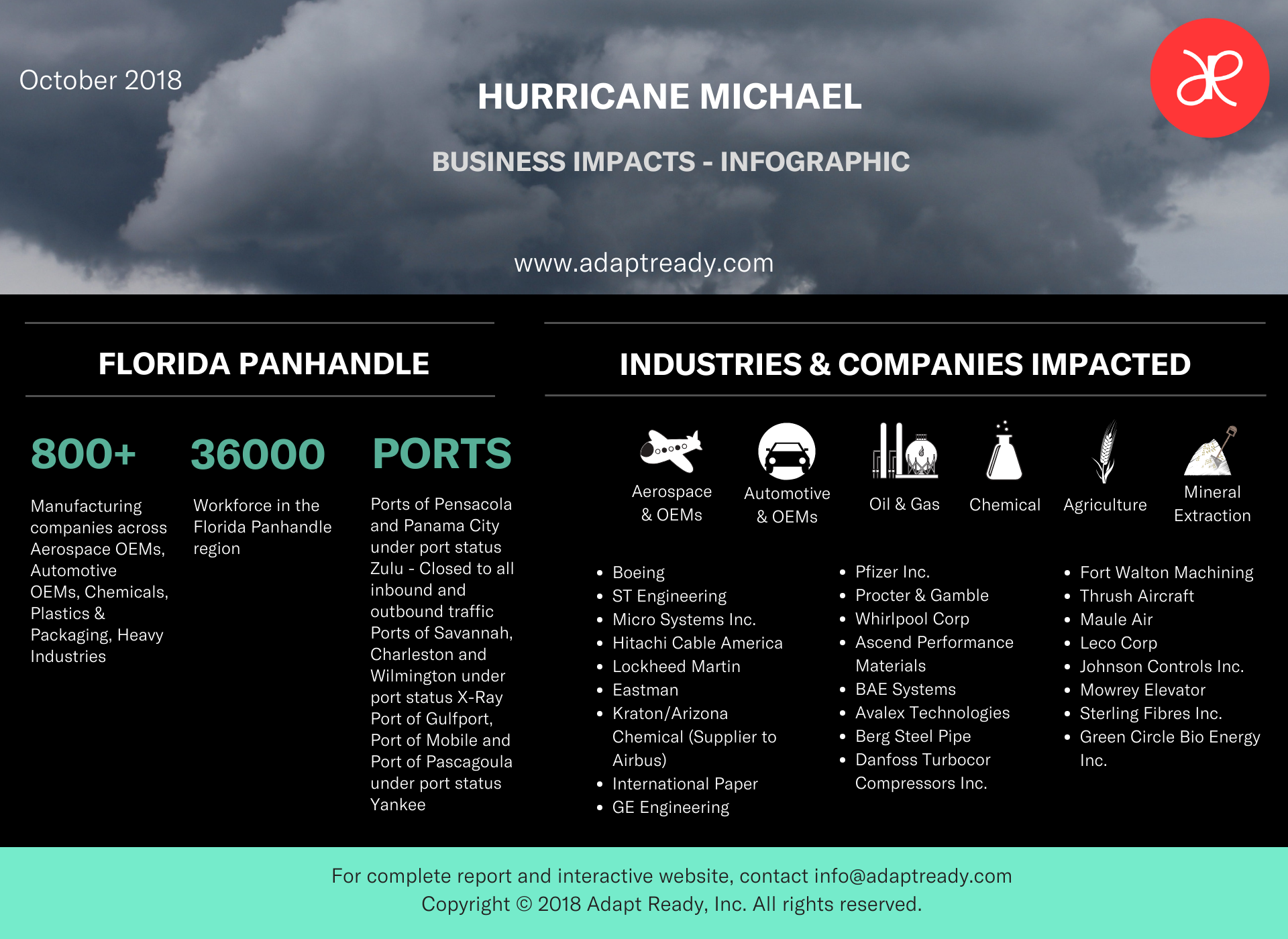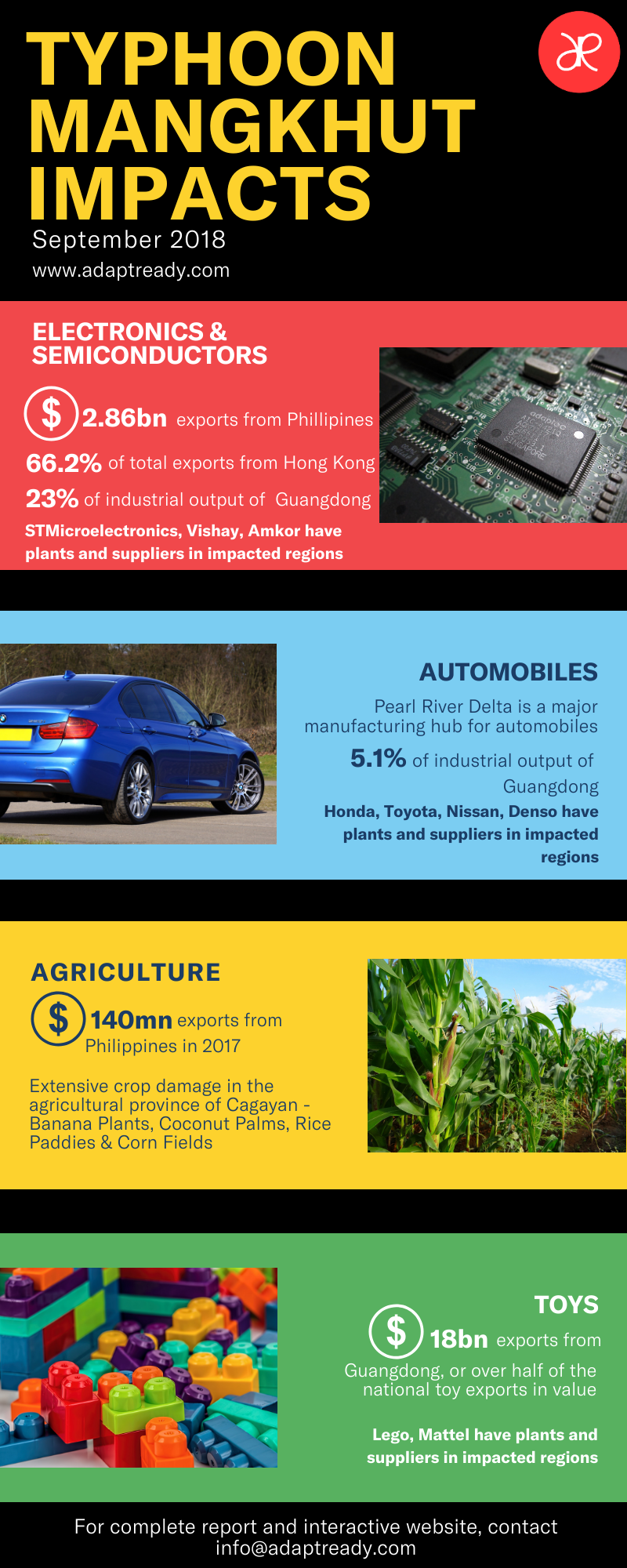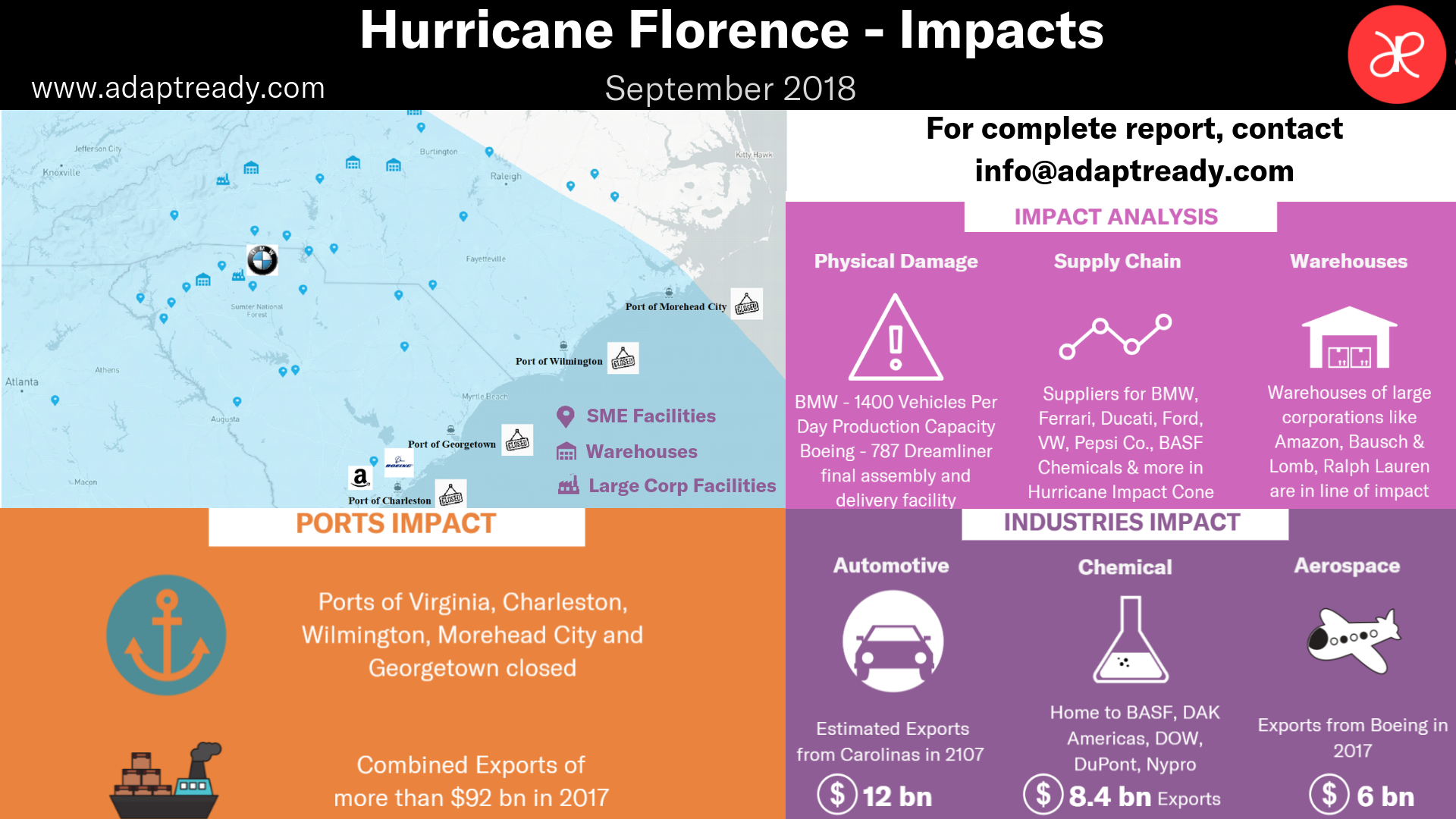Hurricane Dorian, an extremely catastrophic category 5 Atlantic hurricane, caused extensive damage to the aerospace industry, multiple small and medium enterprises and several foreign companies that had operations in the Carolinas.

Hurricane Dorian, an extremely catastrophic category 5 Atlantic hurricane, caused extensive damage to the aerospace industry, multiple small and medium enterprises and several foreign companies that had operations in the Carolinas.

Cyclone Vayu, a strong tropical cyclone, cause damages mostly in the Indian state of Gujarat. Cargo operations were suspended in all ports in the Gulf of Khambat, interrupting exports to multiple countries.
Cyclone Fani, called as the strongest tropical cyclone to make landfall in India in 20 years, battered India and Bangladesh, and impacted several manufacturing companies and industries. A snapshot of the potential impacts can be seen in our business impacts infographic.

Hurricane Michael, a devastating Category 5 hurricane, barreled into the Florida Panhandle region, and impacted hundreds of companies and industries in the region; especially impacting the Aerospace, Automotive and Chemicals industries.

Typhoon Trami, also known in the Philippines as Typhoon Paeng, was the second typhoon to hit Japan within a month; severely impacting Kyushu, Okinawa and Kochi provinces. A snapshot of industries impacted in these provinces can be seen in our infographics.

Typhoon Mangkhut, also known as Typhoon Ompong in the Philippines caused extensive flooding and damages to South China and the Philippines. The pearl river delta region of China was impacted severely, leading to multiple industries like Automotive, Semiconductors and Toys suffering losses.

Hurricane Florence, the first major hurricane of the 2018 Atlantic hurricane season, caused extensive damage to automotive, chemical and aerospace industries in the Carolinas, in addition to all major ports being closed, and supply chain impacts to multiple companies. A snapshot of the impacts can be seen in our infographics.

Hurricane Harvey, a Category 4 hurricane, caused devastating floods in Texas and Louisiana. Texas, being a major crude oil trading hub, and responsible for 22% of offshore oil production of US, businesses there were severely impacted.

2016 Risk Recap – While here you see some highlighted risks, a complete report you can find on the Global Risks Report 2016 by the World Economic Forum.
Earthquakes and Environmental Refugees: Time for “Green” Engineering – analysis – Indonesia was struck by an earthquake in December of 2016 and left 103 people dead, 932 injured and 88,133 displaced from homes.
1,000 structures destroyed in Chile wildfires – Chile has had 238,000 ha burned in a whildfire that started late December, damaging towns, ranches, and vineyards.
‘Unusual’ yellow fever outbreak threatens Brazil’s most vulnerable – Brazil’s second most populous state declared a 180-day state of emergency due to a yellow fever outbreak. The World Health Organization has warned that if the disease continues to spread beyond the state’s borders, it could cause a larger epidemic.
Contagious virus that affects young children reaches epidemic levels in Colorado – “Respiratory Syncytial Virus blocks the airways of people who have the virus. It can be deadly for children 2 and under because their airways are so small it makes it difficult for them to breathe, lowering their oxygen levels.”
More Rain to Come as Floods Leave 43 Dead, 1.6 Million Affected, 500,000 Homes Damaged – Six provinces in Thailand are going river flood caused by extreme, long-term rainfall.
Cagayan de Oro City, in the Philippines, was placed under a state of calamity following massive floods – Seven people were reported dead and the damage to agriculture and infrastructure is estimated at P10 million.
Thai floods may cost up to $3.4 bi if they last for 2-3 months – floods in early January killed 43 people, threatened agriculture and affected about 1.6 million people.
Italy: Abnormal cold front in the south – Italy was hit by unusual and unexpected cold front that affected agriculture and increased heating costs to farmers.
Civilian cost of conflict in Iraq increases amid Daesh threat – “Iraq is threatened by Daesh, which has taken power in several cities, including Iraq’s second largest city Mosul. The country also suffers from sectarian conflict as the government has been prioritizing Shiites, while discriminating against the Sunni population. Besides, corruption accusations against the government have also led to social distractions and the ongoing conflicts have a humanitarian cost.”
Tackling Disaster reduces risk of conflict – “The effects of climate change, population growth, rapid urbanization, and environmental degradation are contributing to greater competition for resources, adding to tensions and instability,”
Strong global investment appetite into Europe despite geopolitical instability – Fourteen percent of foreign investors with a presence in the UK plan to change or relocate some of their European operations in the next three years should the UK leave the European single market. Overall, 11% plan to modify their UK presence in Europe following Brexit. Germany was identified as the preferred destination for those investors moving out of the UK (54%), followed by the Netherlands (33%) and France (8%).
Cyber-Risks
Russia suspected of hacking diplomats’ emails – Hackers infiltrated the emails of dozens of Czech Republic senior diplomats.
Russian spies and cyber expert charged with treason for ‘cooperating’ with US – Arrests were made at a time of tension between Washington and Moscow after US intelligence accused Russian hackers of sabotaging US election in favor of Donald Trump.
Lloyds bank accounts targeted in huge cybercrime attach – After the cyber-attack on Tesco Bank, Lloyds Banking Group suffered 48h online attach by cybercriminals that blocked access from customers.
Saudi Arabia on alert for cyber-attacks – Saudi Arabia’s telecoms authority is on alert for a virus named Shamoon.
Top 10 Risks to the World in 2017 – An analysis from Time
Top five global risks for 2017 – An analysis from the World Economic Forum
The Global Risks Report – Main risks from an Insurance perspective – Zurich
Drought Exacerbates Tensions in Tunisia – A persistent drought is threatening agriculture, leading to protests over water and enhancing existing social tensions in Tunisia.
Companies Taking Water Risk Seriously – Forbes Magazine surveys private sector concerns about water scarcity and business strategies to reduce risk.
Global Climate Risk Threshold Passed – scientists say global CO2 levels surpassed 400 (parts per million) ppm in September. To keep global temperatures from rising 2°C, the Intergovernmental Panel on Climate Change (IPCC) estimates that CO2 ppm levels should stay below 450 ppm.
China Suffers Large Losses from Typhoon – Insured losses on mainland China from September’s Typhoon Meranti are expected to fall between $650 million and $1.15 billion. The intensity and frequency of typhoons that make landfall across the East Asia region have been increasing.
Climate Implications for Risk Assessment and Insurance – Companies can now expect to see higher flood premiums, larger flood deductibles and stricter underwriting standards as new scientific evidence suggests climate has made flooding events from Louisiana to Paris more severe.
BlackRock Advances Climate Risk Assessment – Managing trillios in assets, BlackRock said all investors should factor climate risks into their decision-making and “doing so would not mean having to accept lower returns.”
Climate a Significant Security Risk Says Military – Military and national security experts recommend the federal government to create a cabinet-level official to manage climate and security issues.
Rising Seas Threaten Islands in South Pacific – Island nation of Kiribati, in the South Pacific, might be the first country to be entirely eliminated due to sea level rise in 30 to 50 years.
Mars Chocolate Hires Meteorologists to Forecast Risks – Worried about how extreme weather is impacting its supply chain, Mars has hired meteorologists to better understand climate risks, from disruptive storms to changing growing conditions, for its chocolate supply.
July Was The Hottest Month Ever Recorded – while recent El Niño effects have contributed to recent warming, NOAA scientists say this affect was over in June and that we are still on track for 2016 to be the warmest year on record.
Alaskan Village Decides to Relocate as Seas Rise – as the town of Shishmaref, Alaska has lost up to 3,000 feet of land to coastal erosion in the last 35 years, its residents have voted to relocate the town to a new site.
Exxon Mobile Halts Production as Louisiana Floods Threaten Facilities – the area around Exxon’s Baton Rouge 502,500 barrel per day refinery, received 22 inches of rain, 19 above normal for this time in August, forcing it to shut down four production units.
Extreme Weather and Labor Prices Lead to Price Surge for Cashews – extreme heat and low precipitation in Africa and Asia coupled with rising labor costs in India have led to lower production and prices have increased 20% since the beginning of the year, affecting retailers and food processors around the world.
Zika Virus Damages Puerto Rican Economy – new figures show that tourism in Puerto Rico earlier this year fell due to worries about the Zika virus. 42,000 room nights were lost between March and May 2016.
FEMA Seeks to Move Construction Away from Flood Zones – a FEMA proposal would require federally funded projects to be built 2 feet about the 1-percent-chance annual flood level while for projects like hospitals and nursing homes, FEMA could use tougher standards or apply the best available climate science to determine potential future flood conditions over the lifetime of the project.
NIH Warns Texas, Louisiana Could be Next in Zika’s U.S. Spread – and rising temperatures that lengthen mosquito seasons may contribute to this.
Plastics Industry in Turkey is Worried About Impact of Unrest on Exports – Turkish plastics processors are worried they will lose business as global manufacturers grow nervous about their sourcing in Turkey in the wake of the failed military coup that killed 300 people.
World Bank Report Details Growing Water Scarcity – among its many warning, water scarcity, exacerbated by climate change, could cost some regions up to 6% of their GDP.
US Administration Proposes Requiring Companies to Disclose Climate Risks – the administration recently proposed requiring that all companies doing business with the federal government publicly disclose what they know about their climate-risk exposure. This information will be a factor in taxpayer-funded contracting decisions.
Earthquake in Central Italy Levels Towns – 240 people have died with many more injured after a 6.2 magnitude earthquake. Many of the buildings in the towns hit hardest were made of unreinforced brick or concrete frames, making them vulnerable to earthquakes.
Climate Change may halve the world’s regions suitable for growing coffee – a new report claims that without significant efforts to reduce rising global temperatures, half of the global area suitable for coffee production could become unsuitable for growing coffee by 2050.
Climate Change is Likely to Cause Allergy Misery for Millions – research from the UK points to a doubling of allergies to ragweed across Europe by 2050. The authors simulated how ragweed is likely to expand across the continent as temperatures rise.


